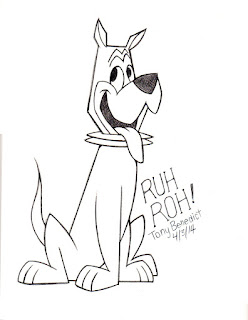What was it like at Hanna-Barbera when brand new Huckleberry Hound and Yogi Bear cartoons were being made (and endorsing Kellogg’s cereals along the way), and The Flintstones was just getting off the lightboard? There aren’t a lot of people around any more who can give you a first-hand answer to that question. But one of them is the man who drew that fine picture to the right, the Father of Astro, writer Tony Benedict.
Tony got out of the service and began his animation career at the Walt Disney studio (yes, Uncle Walt was alive and well then) before moving to UPA, the people who brought you Mr. Magoo. Tony and his writing partner came up with an idea for The Flintstones and submitted it to Hanna-Barbera. That got him a job at the studio in 1960 and soon he was providing storyboard drawings for the non-artist sitcom writers and writing stories for Huckleberry Hound and Yakky Doodle cartoons. He was the inventor of Hitchcock-ish Alfie Gator. Tony worked on many other series before leaving Hanna-Barbera after Taft Communications bought it to set up his own studio.
For a number of years, Tony has been planning and working on a documentary about his career at Hanna-Barbera and the great people and wonderful characters he worked with. The studio revolutionised TV animation and it’s a story that needs to be told. Besides, there are always funny stories aplenty about things that go on in a studio while cartoons are being made, so documenting them would provide good humour for an audience. Putting together the film has been a challenge; money for the rights to use the Hanna-Barbera characters on screen being one of them. It’s gone through a number of concepts, but it’s finally ready.
Tony has put together a 20-minute animated film entitled “Pencil Me In.” It features Tony, in cartoon form, telling how Bill Hanna and Joe Barbera developed television animation. Other than animator/layout artist Mike Lah (who left in 1958 or ’59), Tony worked with every major player in the early days of the Hanna-Barbera studio. He was there when the company moved from a small, windowless, cinder block cube to the bright, cheery plant at 3400 Cahuenga Drive that everyone associates with the studio. He was there when H-B jumped into the made-for-Saturday-morning business and began its domination.
“Pencil Me In” will premiere at the Los Angeles International Short Film Festival on Friday, September 4th at 1 p.m., screening at the Regal Cinemas L.A. LIVE Stadium 14. I’m sure Tony will let us know more after that. Check out his website HERE.
Tony got out of the service and began his animation career at the Walt Disney studio (yes, Uncle Walt was alive and well then) before moving to UPA, the people who brought you Mr. Magoo. Tony and his writing partner came up with an idea for The Flintstones and submitted it to Hanna-Barbera. That got him a job at the studio in 1960 and soon he was providing storyboard drawings for the non-artist sitcom writers and writing stories for Huckleberry Hound and Yakky Doodle cartoons. He was the inventor of Hitchcock-ish Alfie Gator. Tony worked on many other series before leaving Hanna-Barbera after Taft Communications bought it to set up his own studio.
For a number of years, Tony has been planning and working on a documentary about his career at Hanna-Barbera and the great people and wonderful characters he worked with. The studio revolutionised TV animation and it’s a story that needs to be told. Besides, there are always funny stories aplenty about things that go on in a studio while cartoons are being made, so documenting them would provide good humour for an audience. Putting together the film has been a challenge; money for the rights to use the Hanna-Barbera characters on screen being one of them. It’s gone through a number of concepts, but it’s finally ready.
Tony has put together a 20-minute animated film entitled “Pencil Me In.” It features Tony, in cartoon form, telling how Bill Hanna and Joe Barbera developed television animation. Other than animator/layout artist Mike Lah (who left in 1958 or ’59), Tony worked with every major player in the early days of the Hanna-Barbera studio. He was there when the company moved from a small, windowless, cinder block cube to the bright, cheery plant at 3400 Cahuenga Drive that everyone associates with the studio. He was there when H-B jumped into the made-for-Saturday-morning business and began its domination.
“Pencil Me In” will premiere at the Los Angeles International Short Film Festival on Friday, September 4th at 1 p.m., screening at the Regal Cinemas L.A. LIVE Stadium 14. I’m sure Tony will let us know more after that. Check out his website HERE.





.png)


.png)







































































































































































































































